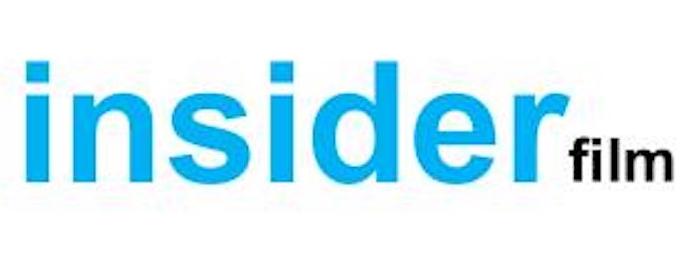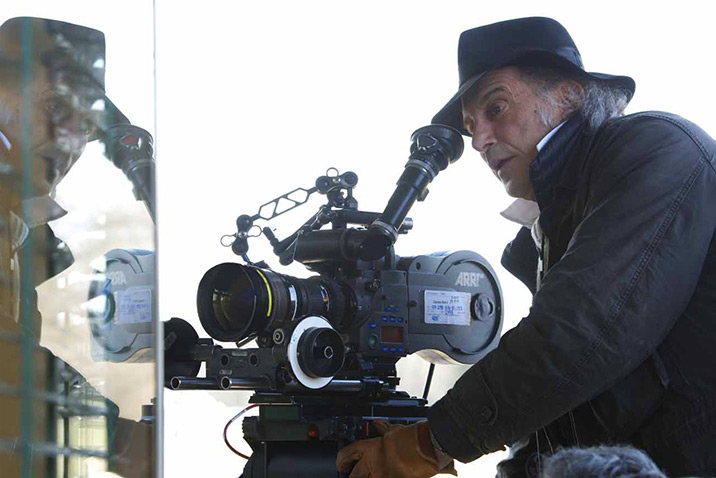The man with the movie camera
After our long interview in Espinho, near Oporto, and two master classes in FEST, Training Ground, the man who shot Carol and Wonderstruck, for Todd Haynes, but also did camera work on Steven Soderbergh’s Erin Brockovich and The Limley, Sofia Coppola’s The Virgin Suicides, among great films from Paul Schrader, Todd Solondz and Ulrich Seidl, kept the conversation going for another half hour. As he was with a Portuguese journalist, Mr. Lachman wanted to know if he could meet the filmmaker Pedro Costa (Horse Money). Showing a genuine taste for Portuguese cinema, he made me write down in his notebook my favorite film of Miguel Gomes (Tabu) and also the name of this young chap that I told him about, Pedro Pinho, which won the Fipresci award in Cannes (Director’s Fourthnight) with The Factory of Nothing.
It’s clear that Edward Lachman doesn’t want to loose time. Probably that’s why he carries his pocket camera at all time. In a way, an extension of his own eye. But at FEST – New Directors, New Films Festival (from June 19th to 26th) the man with the black hat was always available from a chat. “I’m sure I get as much as meeting this young people as they get out of me”, he will say in our interview. Which is actually true. We talked cinema several times before our interview. Even so, we had some points that we needed to make clear.
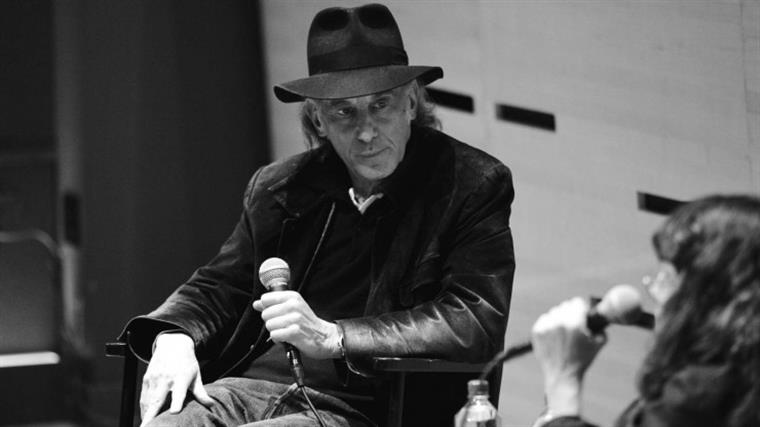 Insider – Let’s start by an obvious question. How was your time here in Portugal, Espinho, at FEST?
Insider – Let’s start by an obvious question. How was your time here in Portugal, Espinho, at FEST?
Ed Lachman – I was a couple of years in Portugal. In Vila do Conde, I think there’s a wonderful film festival.
That’s the one I’m going afterwards.
Oh, are ya? But this festival is wonderful. There’s such a divergence of people and experiences. And the professional people they brought in are very varied. Between commercial and non-commercial cinema. And I like that is based on personal people’s experiences and aesthetics than just technical. It always works well when everybody’s thrown together. We eat in the same places, we go to the same bar. We see the same films. So, we’re forced in a way to meet each other. In a good way. I’m sure I get as much as meeting this young people as they get out of me. The ability and the talent of this young people is quite remarkable.
The work you do has mostly to do with a camera and what you see through it. I’m curious of what you see when you pick up a camera and you’re about to shoot. What is that you expect?
It’s not the technical end, it starts on how I perceive the world we live in. I do relate to things through images better than anything else. Even here I walk around with a camera all the time. The camera is just an extension on how I perceive things. I always feel that images are what you imbue in the image, the subjectivity that the photography experiences with the subject. I’m not that technical as a person.
I’ll be correct if I say that you may prefer to capture the past and the period in films?
That’s just because the films I worked with Todd (Haynes) are mostly period films. But I’m just more interested in the found object, in what I see around me. That came maybe out of documentary, but also the photographers that I became interested, like Robert Frank, Larry Clark and Cartier Bresson. I’m much more engaged in that. Todd uses film language as a visual metaphor for the storytelling. There is a sense of naturalism, of visual reality, like in Mildred Pierce or even Carol, we were looking at the photographers in that period, on how they represented the reality in that time, rather than the cinematic conventions. Far From Heaven was Douglas Sirk, in a heightened maneristic reality of Brechtian ideas of imagens that weren’t naturalistic but somehow would affect the audience emotionally.
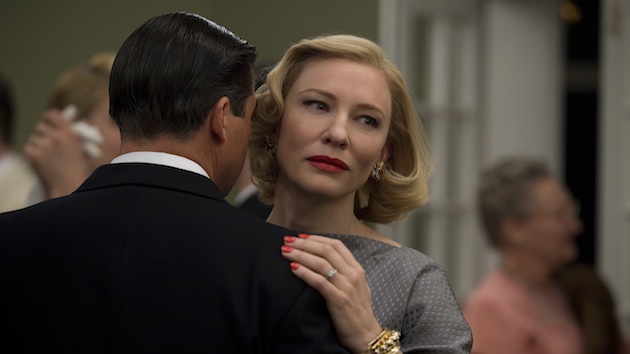 But in Carol you have a different approach to period than in Far From Heaven. Even if it’s roughfully the same period.
But in Carol you have a different approach to period than in Far From Heaven. Even if it’s roughfully the same period.
Yeah, yah. Because, like I say we looked at mid century photographers and not at cinema per se. We looked at Ruth Orkin, Helen Levitt, Esther Bubley and later Vivian Maier. There were artists that were in the streets of New York, the urban areas. And they were documenting the time through color photography. Before that, color photography was seen as commercial, not as an art form. Black and white was the norm. In Carol we have a lived in reality, a melodrama of the early fifties. The period after war was quite austere and not as materialistic as the mid to late fifties. Patricia Highsmith wrote this book in 1949, outside of the crime milieu. She was known for her first book Strangers on a Train. It mirrored the emotional reservedness, when you did not express your feelings openly. That’s what we were looking at visually. But we were incorporating the subjectivity of the view point of the amorous mind, of someone falling in love, but also dealing with the reservedness of these characters that would be in the time period of that time.
But in Carol the subjectivity is taken to another level.
Yes, that’s when the characters become hidden in scene. Another reason why we were using super 16 because we wanted to feel the emotion, the grain of the film would give an emotional quality to the film that you could feel underneath them on the surface. Maybe that’s more universal than just a lesbian love story. Todd always said that Paricia’s Highsmith writings were about the subjective mind: would I be caught or not? But the crime in the book was their love. So, it fits that kind of subjectivity that Patricia Highsmith wrote about in her thrillers. Images in any story, for me, are finding the visual metaphor for the storytelling. That’s what I’m always searching with the director, how to tell the story with the emotions for the characters.
When did you discovered that you wanted to tell stories with images?
My father was an amateur photographer, and when I was young I hated cameras. I thought that they see would steal your soul. When I was teenager I used to travel to Europe. Every summer I would go to three or four countries. My father’s company was in France.
That explains your latter connection with European cinema…
Yes, in a way I always felt a connection to Europe. Even more so to the States. I was in Art History, I was studying painting in Harvard and I took an easy course in film appreciation, where we looked at movies and we talked about movies. It struck me, that those images would go on a screen with a reason.
Remember the films that struck you most?
It was Umberto D (from Vittorio De Sica), an Italian nonrealistic film that was constructed with images and primarily without any dialogue. The idea that you could construct a story with images and without words. As a painter I would need years to develop a technique, so I understood mora about painting than I was able to execute. The idea that I could pick up a camera and apply ideas visually of that I understood about, depth, color, form and shape, special relationships, and that you could do that with a camera was what really engaged me with the idea that I could do that. So, I made little portraits of people, similar to the one I shown with a cell phone (at his master class in FEST). People liked the way they looked, because I thought different schools of painting and apply those visual ideas telling a story.
And that’s exactly what you do now…
Yes, in a weird way it was a micro cosmos. As peopled liked the way they looked they asked me to shoot for them. So, I thought that would be an unexpensive way to learn how to make films, through other people. That’s why I became a cinematographer, I could get payed and make a living.
But why didn’t you became a film director? Did that also cross your mind?
The thing that I find frustrating about directing is as a cinematographer I can work all the time, but as a director it takes years of getting projects together. I always done my little projects in between.
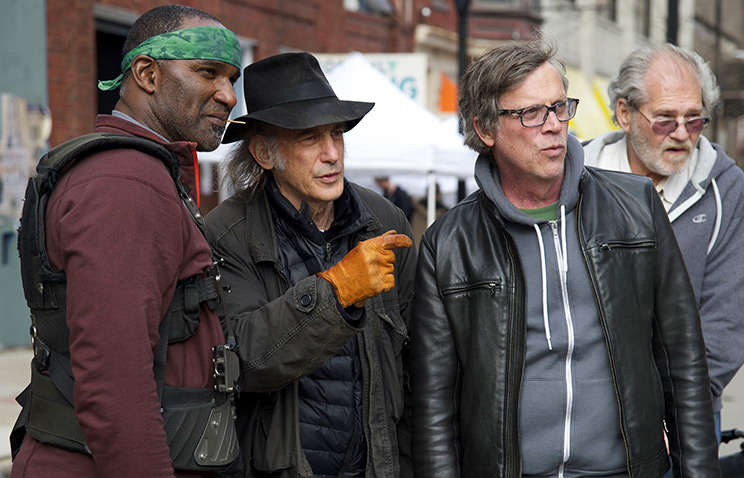
Do you feel that in your work with Todd Haynes you are close to be a filmmaker?
Todd comes out of an art school too, in semiology, the art of studying aesthetics of images. We have a very fluid relationship that way about creating images and ideas. I can say I have the same creative relationship with Paul Schrader, who is very aware of the aesthetic of images. I also did a film with David Byrne (Stop Making Sense). I’ve been very lucky to work with directors that are visually themselves. Like Ulrich Seidl. Even if it’s not my language I’m able to plug in to their world and try to contribute to it.
I’m sure this question pops out regularly. You worked in Europe and you have part of your roots here. But when you’re asked which filmmaker influenced you most what do you say?
It changes. I feel that directors in Europe feel they need to express themselves in their own language. A Wenders film is different from a Bertolucci film. Ulrich Seidl in different from Fassbinder. In American we shoot for the editing room a lot of the times. There is a certain convention of the language on how you tell the story. I should not say Europe, but independent filmmaking. There are a lot of young filmmakers, like Sean Baker, that shot a film with a cell phone, Tangerine, and has his new film Florida Project. And there is this new Italian American filmmaker, Jonas Carpegiano (A Ciambra). It’s more a division between the idea you don’t have all the time and the money so the camera becomes more a point of view in the story rather than creating options form yourself later.
Let me ask you, when you see the films you shot, what do you see, really? Because it might not be exactly what you envisioned, after the editing process.
What I can say is the longer time I have away from what I done I can see it differently. If I’m too close to it I don’t have enough distance. I always say this, when you’re shooting a film you go with some preconceived ideas and approaches but you don’t know if it’s really working or not over a period of time. It might be a week, a few weeks, it might be after the film is edited.
Was there a time when you didn’t feel satisfied with the result?
I’m sure there are films where I worked on that I wasn’t realized, sometimes for the better, sometimes not. Look, the audience completes the film, you know? It’s interesting what people pick up on or feel.

There’s also the personality of the director. Nick Ray, Herzog, Haynes…
Those were people that were very strong, with visual ideas and sense of storytelling. I also worked with Todd Solondz. He approaches images a little different, through his writing and story. He doesn’t want the images to overstate or take over. It’s much more dialogue driven. Once I showed I could equate to his words visually he was more open to visualizations with the camera.
Also, your work with Sofia Coppola was very beautiful. How did you work with her in Virgin Suicides?
Yes, she has a visual sense, but she allowed me to collaborate to create this two worlds. This adolescent world of girls, and the adolescent male world trying to understand the female world. I tried to create these two different worlds. I create this period 70’s feeling with grain. The girl’s world had magentas and blues, they were imprisoned in house, and then the boys were on the outside, in a neutral to warm colors, the optimism.
There are the colors again… The artistic look at cinema.
Yes, because I studied painting, another tool to create emotion. There have been studies that show how color creates emotions in the viewer. So, I thought I could create that cinematographically.
If I asked you which film was for you the most complicated one would you say I’m Not There?
That would be a good example, because it was dealing with so many different genres, styles, black and white.
Or maybe Wonderstruck…
Yes, Wonderstruck too, because it was a big film, also creating the 20’s and the 70’s. But you’re right, I guess it would be I’m Not There, because it was creating not only black and white but also the French nouvelle vague, modern Italian cinema that grew out of neo realism. And there was also the modern anti-hero of the 70’, with Peckinpah, Altman… We were creating not only different looks but also different aesthetics toward the image that were part these different characters were that Dylan is evoking. You’re probably right, that was probably the most complicated work.
But I also see some connections in Wonderstruck, because you had to shoot something that is not obvious. When I saw the film in Cannes I felt that I was learning to see and hear again. In a way, discovering film.
Oh, that’s interesting, because Wonderstruck is about the subjectivity of hearing through seeing. So, in a way it was a bit like the discovering of cinema. I didn’t realize this but for the deaf community this was their cinema. Again, it was to create a subjectivity with the camera for those characters.
That’s way I say that Wonderstruck is more an Ed Lachman film than Todd Haynes film.
That’s not fair, because people say things like that but I cannot divorce Todd’s approach to images. Yes, I execute that approach, but it was Todd’s idea how to do that. The longer lenses, the moving shots, recreating the 70’s feeling where the camera has this suspension that flows. That’s was Todd’s idea how to recreate that. Now, I figured out how to do it and how to execute it. I can divorce what I do to Todd, he does an incredible look book.
Which films did you see for that one?
Maybe the one I connected to most was The French Connection, but also Murnau for the silent piece. Also, King Vidor, The Crowd, and The Wind, from (Victor) Sjostrom.
Of course, I have to ask you about Larry Clark. You said already you liked his photography work and you’ve also co-directed Ken Park. What can you say about this collaboration?
I enjoyed his work, and Robert Frank, because these photographers were immersed in the world they were photographing. In the case of Robert Frank, it’s a reality that has this poetic realism. In Larry’s case, it’s something different. Here was an artist that was documenting his own life experience. I met him in Grass, Austria, fifteen years ago, at an art fair. And I said to him at a dinner, “your books are so seminal and so important to me”. But they were like films to me, there was a story on the page. And I said if he had tried to make a film.
So that was pre-Kids?
Oh, absolutely. I was the first person who made him get interested in films. I asked if he kept a diary when he was growing up. He was into skating, I was a skater when I was a kid, and I suggest to make a film together. I wanted to document something about Larry Clark. Out of this came a script, but none of us were writers. So, we met Harmony Korine in Washington Square Park. I knew Harmony, he was a PA in Light Sleeper (from Paul Schrader), and I thought we could tell a collective story through a skate park about this kids parenting themselves. Out of that came Ken Park. There was also a series of aids related stories; Gus Van Sant was going to do one of them, but then he couldn’t do it, so he asked Larry to do it. Out of that came Kids. He went off and made Kids, with Harmony, and then, years later, we get to make Ken Park together.
That’s a great story.
That’s what happened.
Just to finish, I’m also curious about your most rewarding film. And I also have this option for you: Far From Heaven or Carol?
Well, Carol seems to have the best response from people.
But for me, I have to say, I love Far From Heaven. It’s as good as Sirk’s original.
I can’t say. But I’ll say this: Ulrich Seidl excites me the most. I did four films with him. He’s doing a film now. But there’s parts of both Todds’ films in proud of. I can’t really say. Hopefully I haven’t done it yet.
